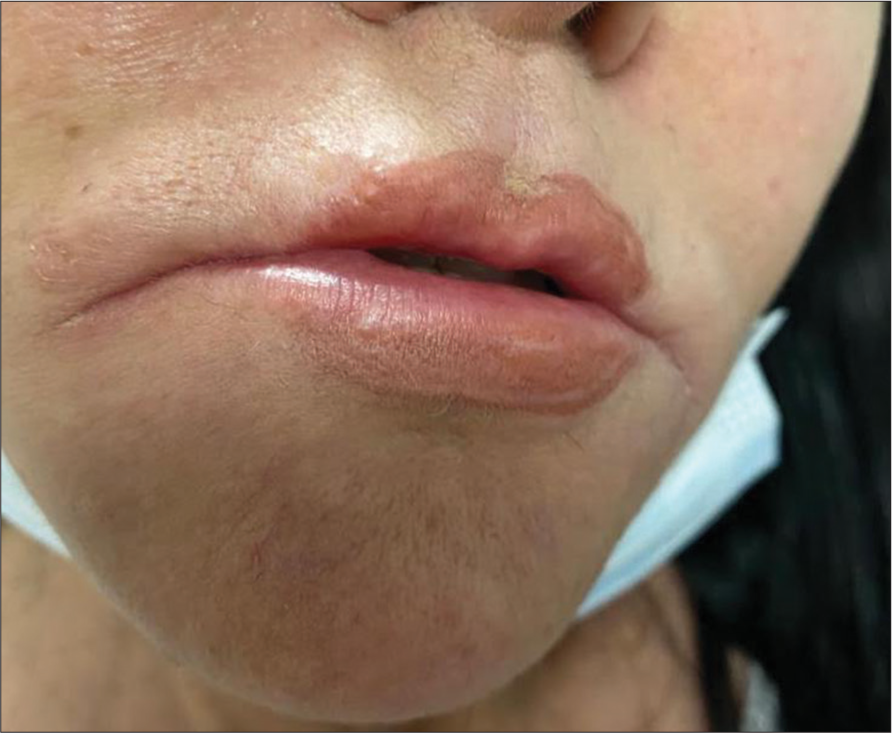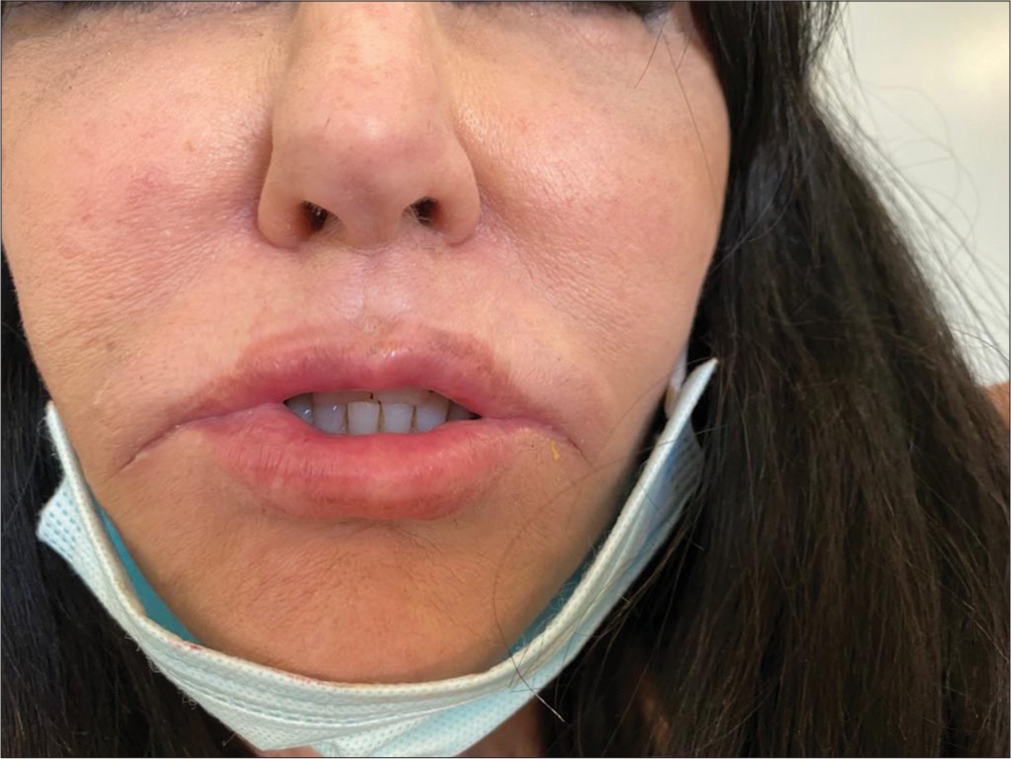Translate this page into:
Homemade lip injection for cosmetic purpose: A case report
*Corresponding author: Antonella Tammaro, Department of Neuroscience, Mental Health and Sense Organs, Dermatology, Sapienza University of Rome, Rome, Italy. tammaroantonella@gmail.com
-
Received: ,
Accepted: ,
How to cite this article: Tammaro A, Adebanjo G, Gelormini E, Greco M, Parisella F, Chello C, et al. Homemade lip injection for cosmetic purpose: A case report. Indian J Skin Allergy. 2024;3:145-6. doi: 10.25259/IJSA_42_2023
Dear Editor,
A 56-year-old woman presented to the dermatology outpatient clinic with complaints of lip swelling and erythema for one week duration. Cutaneous examination showed lip induration, tenderness, and erythema [Figure 1].

- Indurated lips along with erythema after self-injection of sunflower oil.
She did not consent to a skin biopsy, as it would have altered the appearance of her lips. Ultrasound of the lip with a high-frequency probe highlighted the presence of soft-tissue swelling of both lips, especially on the left lateral side of the inferior labium. Between the left lip and the left zygoma, a region of mixed echogenicity (maximum axial diameter = 1.5 cm) was found.
Laboratory investigations were within normal limits. A diagnosis of lip injection with an unidentified substance was made. Eventually, the patient revealed that she had recently self-injected sunflower oil into her lips for cosmetic purposes, which she had obtained from a common supermarket. She was treated with broad-spectrum antibiotics and a dietary supplement to improve her lip swelling (50 mg Serrazimes® and 200 mg Protexil®). The patient refused psychiatric consultation. At a two-week follow-up visit, the labial induration and erythema had increased because she had again self-injected sunflower oil [Figure 2]. At this time, the patient refused any medical or surgical treatment.

- Prominent lip induration and erythema after second injection of sunflower oil into her lips.
Non-surgical techniques employing injectable alloplastic materials have quickly developed into one of the most popular esthetic procedures.[1] Unregistered compounds, particularly oils, which are known to affect the subcutaneous tissue adversely, might have fairly significant negative side effects.[1] Over the years, several studies have described the outcomes of self-injected materials for cosmetic purposes.[2-4] Impurity-bearing oils, such as those containing fat-soluble vitamins derived from gel capsules, are not recommended for cosmetic injection.[1,2]
Torre et al.[2] described a 51-year-old woman who self-injected the oil from Vitamin A capsules into her lips and developed multiple subcutaneous nodules. Similarly, a Turkish case report described a 45-year-old woman with major depression who injected bovine fat in a liquid form into her lips and other portions of her face.[3] To determine the management and the position of the foreign material, magnetic resonance imaging has been employed. In the past few years, there has been growing evidence in the published medical literature, regarding the effectiveness of noninvasive imaging techniques like high-frequency ultrasound to evaluate and characterize the complications of lip-filling procedures such as granulomas, vascular compression, fibrosis, and more.[5,6] Skrzypek and Mlosek.[5] were able to identify post-procedural complications in five women (mean age = 37.4 years), who had undergone lip augmentation injections. The ultrasound diagnoses included massive fibrosis, granulomas, and “persistent deposit nodules.” Similarly, we were able to pinpoint the precise position of the foreign substance that our patient had self-injected due to high-frequency ultrasonography. We describe this case to highlight the improper techniques adopted by patients for cosmetic purposes, leading to undesirable outcomes.
Ethical approval
The Institutional Review Board approval is not required.
Declaration of patient consent
The authors certify that they have obtained all appropriate patient consent.
Conflicts of interest
There are no conflicts of interest.
Use of artificial intelligence (AI)-assisted technology for manuscript preparation
The authors confirm that there was no use of artificial intelligence (AI)-assisted technology for assisting in the writing or editing of the manuscript and no images were manipulated using AI.
Financial support and sponsorship
Nil.
References
- Oil-soluble vitamins: Illegal use for lip augmentation. Facial Plast Surg. 2014;30:635-43.
- [CrossRef] [PubMed] [Google Scholar]
- Facial lipogranulomas due to self-injection of vitamin A oil. Int J Womens Dermatol. 2019;5:126-8.
- [CrossRef] [PubMed] [Google Scholar]
- An unusual case of self-injected bovine fat in liquid form to the face for cosmetic reasons. Aesthetic Plast Surg. 2004;28:251-3.
- [CrossRef] [PubMed] [Google Scholar]
- High frequency ultrasound assessment of labial glands simulating small nodules or granulomas after lip augmentation. J Ultrason. 2021;20:e261-7.
- [CrossRef] [PubMed] [Google Scholar]
- Comparative ultrasonographic and histomorphologic examination of the lips. HNO. 2014;62:879-85.
- [CrossRef] [PubMed] [Google Scholar]





